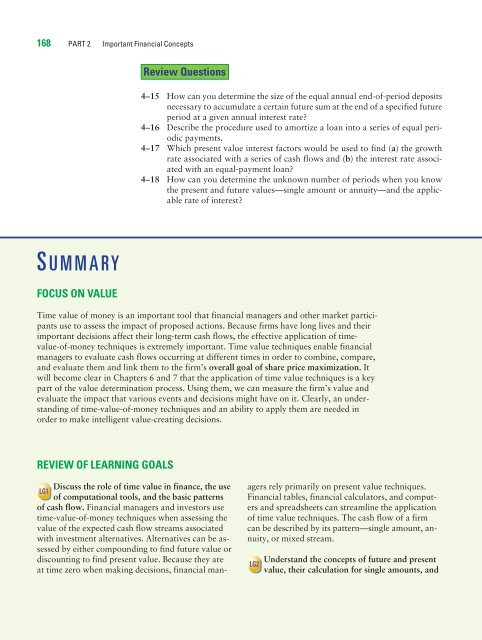Read the Chapter 4 E-Book
Read the Chapter 4 E-Book
Read the Chapter 4 E-Book
Create successful ePaper yourself
Turn your PDF publications into a flip-book with our unique Google optimized e-Paper software.
168 PART 2 Important Financial Concepts<br />
S UMMARY<br />
FOCUS ON VALUE<br />
Review Questions<br />
4–15 How can you determine <strong>the</strong> size of <strong>the</strong> equal annual end-of-period deposits<br />
necessary to accumulate a certain future sum at <strong>the</strong> end of a specified future<br />
period at a given annual interest rate?<br />
4–16 Describe <strong>the</strong> procedure used to amortize a loan into a series of equal periodic<br />
payments.<br />
4–17 Which present value interest factors would be used to find (a) <strong>the</strong> growth<br />
rate associated with a series of cash flows and (b) <strong>the</strong> interest rate associated<br />
with an equal-payment loan?<br />
4–18 How can you determine <strong>the</strong> unknown number of periods when you know<br />
<strong>the</strong> present and future values—single amount or annuity—and <strong>the</strong> applicable<br />
rate of interest?<br />
Time value of money is an important tool that financial managers and o<strong>the</strong>r market participants<br />
use to assess <strong>the</strong> impact of proposed actions. Because firms have long lives and <strong>the</strong>ir<br />
important decisions affect <strong>the</strong>ir long-term cash flows, <strong>the</strong> effective application of timevalue-of-money<br />
techniques is extremely important. Time value techniques enable financial<br />
managers to evaluate cash flows occurring at different times in order to combine, compare,<br />
and evaluate <strong>the</strong>m and link <strong>the</strong>m to <strong>the</strong> firm’s overall goal of share price maximization. It<br />
will become clear in <strong>Chapter</strong>s 6 and 7 that <strong>the</strong> application of time value techniques is a key<br />
part of <strong>the</strong> value determination process. Using <strong>the</strong>m, we can measure <strong>the</strong> firm’s value and<br />
evaluate <strong>the</strong> impact that various events and decisions might have on it. Clearly, an understanding<br />
of time-value-of-money techniques and an ability to apply <strong>the</strong>m are needed in<br />
order to make intelligent value-creating decisions.<br />
REVIEW OF LEARNING GOALS<br />
Discuss <strong>the</strong> role of time value in finance, <strong>the</strong> use<br />
LG1<br />
of computational tools, and <strong>the</strong> basic patterns<br />
of cash flow. Financial managers and investors use<br />
time-value-of-money techniques when assessing <strong>the</strong><br />
value of <strong>the</strong> expected cash flow streams associated<br />
with investment alternatives. Alternatives can be assessed<br />
by ei<strong>the</strong>r compounding to find future value or<br />
discounting to find present value. Because <strong>the</strong>y are<br />
at time zero when making decisions, financial man-<br />
agers rely primarily on present value techniques.<br />
Financial tables, financial calculators, and computers<br />
and spreadsheets can streamline <strong>the</strong> application<br />
of time value techniques. The cash flow of a firm<br />
can be described by its pattern—single amount, annuity,<br />
or mixed stream.<br />
LG2<br />
Understand <strong>the</strong> concepts of future and present<br />
value, <strong>the</strong>ir calculation for single amounts, and

















